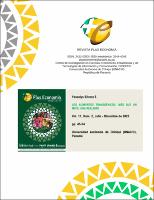Los alimentos transgénicos, mas que un mito, una realidad.
Abstract
Currently, transgenic crops have increased throughout the world. However, scientists around the world still do not agree on their safety. Consumer associations and some scientists argue that not enough tests have been carried out on humans and that these foods represent a danger to the environment as they contaminate the native seeds of many countries, while the large transnationals and other researchers maintain that transgenic foods are the solution to world hunger and are harmless. The reality is that there are currently many countries where there is no legislation on the labeling of transgenic, so consumers do not have a choice. The objective of this article is to collect information about the history, legislation, and the development of methodologies to detect transgenic elements in food, as well as to evaluate the arguments for and against the consumption of transgenic foods. Actualmente se han incrementado los cultivos transgénicos en todo el mundo. Sin embargo,los científicos aún no se ponen de acuerdo sobre la inocuidad de los mismos. Asociaciones de consumidores y algunos científicos aducen que no se han realizado suficientes pruebas en humanos y que estos alimentos representan un peligro para el ambiente pues contaminan las semillas autóctonas de muchos países, mientras que las grandes transnacionales y otros investigadores sostienen que los alimentos transgénicos son la solución al hambre mundialy son inocuos. La realidad es que actualmente hay muchos países donde no existen legislaciones sobre el etiquetado de los transgénicos, por tanto los consumidores no tienen posibilidad de elegir. El objetivo de este artículo es recopilar información acerca de la historia, legislación, y el desarrollo de metodologías para detectar elementos transgénicos en alimentos, así como también evaluar los argumentos a favor y en contra del consumo de alimentos transgénicos.
URI
http://jadimike.unachi.ac.pa/handle/123456789/843https://revistas.unachi.ac.pa/index.php/pluseconomia/article/view/684

